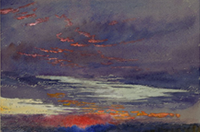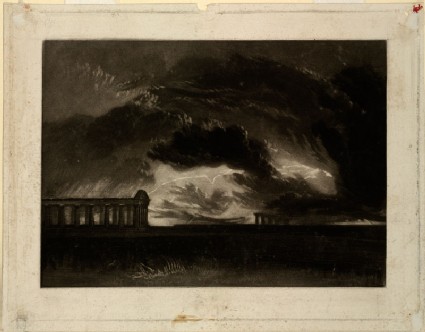Ruskin's Educational series, 2nd ed. (1874)
Ruskin's revised catalogue of 300 works for the instruction of undergraduates and his notes on the use of particular examples.

Ruskin's Catalogues: 1 object
Show search help- Reference URL
Actions
Pæstum (Plate from the "Little Liber Studiorum") Turner
-
Ruskin text
8 D Study of storm-cloud. Engraved by Turner himself, experimentally. E -
Details
- Artist/maker
-
Turner (Joseph Mallord William Turner) (1775 - 1851) (designer, engraver)
- Object type
- Material and technique
- mezzotint on paper
- Dimensions
- 191 x 255 mm (plate); 208 x 267 mm (sheet)
- Inscription
- Verso:
just above centre, the Ruskin School's stamp
just below, in ink: T. 12.
bottom, right of centre, in graphite: R 172 Paestum
just above, in graphite: R 799(d)
- Provenance
-
Presented by John Ruskin to the Ruskin Drawing School (University of Oxford), 1875; transferred from the Ruskin Drawing School to the Ashmolean Museum, c.1949.
- No. of items
- 1
- Accession no.
- WA.RS.RUD.172
-
Subject terms allocated by curators:
Subjects
-
References in which this object is cited include:
References
Ruskin, John, Catalogue of the Educational Series (London: Smith, Elder, 1871), cat. Educational no. XII.8.D
Ruskin, John, Catalogue of the Educational Series (London: Spottiswoode, 1874), cat. Educational no. 294
Rawlinson, W. G., The Engraved Work of J. M. W. Turner, 2 (London: Macmillan, 1908-1913), no. 799
Ruskin, John, ‘Rudimentary Series 1878’, 1878, Oxford, Oxford University Archives, cat. Rudimentary no. 172
Ruskin, John, ‘The Ruskin Art Collection at Oxford: Catalogues, Notes and Instructions’, Edward T. Cook and Alexander Wedderburn, eds, The Works of John Ruskin: Library Edition, 39 (London: George Allen, 1903-1912), 21, cat. Rudimentary no. 172 & Educational no. 294
Location
-
- Western Art Print Room
Position in Ruskin’s Collection
Ruskin's Catalogues
-
Ruskin's Educational series, 1st ed. (1871)
8 D Study of storm-cloud. Engraved by Turner himself, experimentally. E -
Ruskin's Educational series, 2nd ed. (1874)
294. Study of storm-cloud. Engraved by Turner himself, experimentally. E -
Ruskin's revision to the Rudimentary series (1878)
172.Advanced state of the same subject, never finished; but both superb examples of easy and perfect shading in Mezzotint. Compare the lurid glare blaze of the light here with its translucent calm in 162, and be thankful, first, to Heaven for giving us metal that may be thus engraved, and then to Prince Rupert for finding out how to engrave it, and then to Turner for thus writing upon it so noble scripture. The great Plate engraved by Prince Rupert with his own hand (Reference Series No 110.) should be compared at once with this, to show the range of execution in this material. Few collections can possess so interesting plates; their market-value, great though it is, not at all representing their rarity. The Turner-engravings are worth, at least, fifteen guineas each in any London sale room, and I paid Messr.s. Colnaghi fifty guineas for No. 110.





